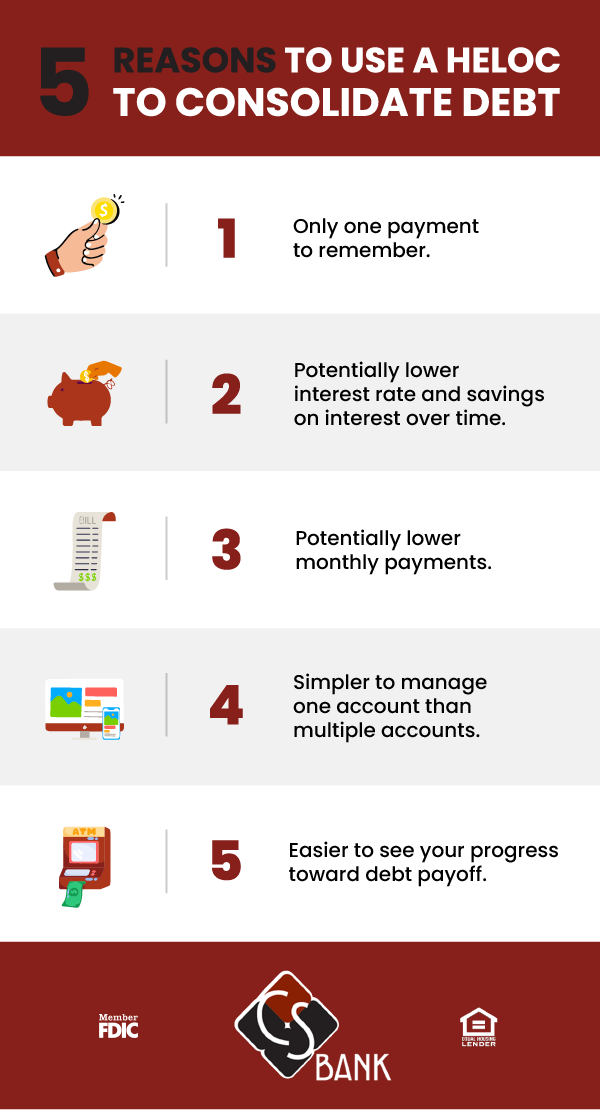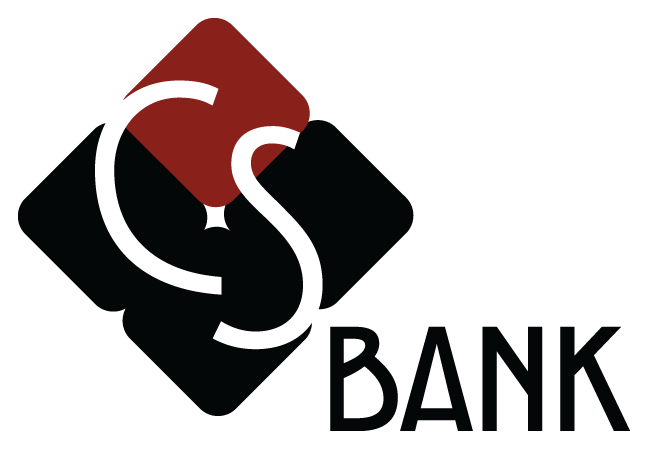%20(7).jpg)
Should You Use a HELOC to Pay off Debt
As interest rates continue to stay high across the board, individuals with debt—especially debts with variable interest rates like credit cards—may find their balances growing faster than they can keep up with them. Home equity lines of credit (HELOCs) are known for their lower interest rates than many consumer loans and could offer relief for those struggling with ballooning balances. However, as with any specialized lending product, it’s important to consider all their characteristics, benefits, and drawbacks before signing on the dotted line.
Curious about how to get rid of credit card debt or lower debt with a HELOC, and if they make sense for your financial situation? In this blog post, we’ll discuss their basic features, eligibility requirements, and their best cases for use—so you can see if they are right for you!
What is a HELOC?
A HELOC is a lending product that, like a home equity loan, is secured by the equity you have in your home (your home’s value minus what you owe on it). Unlike a home equity loan, which is structured similarly to a mortgage, a HELOC is a revolving line of credit that functions similarly to a credit card. It has no fixed interest rate or monthly payment. Also like a credit card, you have a spending limit (from 80% to 100% of your equity, depending on the lender). HELOCs often have a debit card or checkbook that you can use to spend directly from your line of credit, or you can make transfers into your other bank accounts when you need to access the funds.
HELOCs have two phases, a draw phase and a repayment phase. During your initial draw phase, you can borrow against your HELOC up to the limit, making interest-only payments, and your required monthly payment can go up or down, depending on your usage. Draw phases typically last 5-10 years. After your draw phase, you’ll enter a repayment period. You won’t be able to “draw” on your line of credit anymore, and you will begin making regular payments for both interest and principal.
HELOCs can feel like complicated lending products, but once you understand the basic premise and how to use them, they can be valuable tools for funding upfront and ongoing expenses. To understand the ins and outs of HELOCs, check out our post, What is a HELOC and How Does It Work?
HELOC vs. Personal Loans
Just like a personal loan, and you don’t have to tell your lender what you will use them for. So, what are the differences between a HELOC and a personal loan?
- While HELOCs are secured by your home, personal loans are often not secured by anything.
- HELOCs are a line of credit—not a lump sum payout.
- HELOCs do not have fixed interest rates or repayment schedules.
- Because HELOCs are secured, they usually offer lower interest rates than personal loans.
While you may choose to utilize a HELOC instead of a personal loan to take advantage of lower initial payments and lower interest rates, some homeowners may prefer not to secure loans with their home unless they are using it expressly for home repairs and improvements. The IRS affirms this specific use, allowing you to deduct interest on HELOCs only used for home improvement.
Reasons to Use a HELOC to Consolidate Debt
When you have a lot of different debts—especially when there are some with high interest rates, it makes a lot of sense to consolidate them to one loan. Why? Consolidating debt means:
- Only one payment to remember.
- Potentially lower interest rate and savings on interest over time.
- Potentially lower monthly payments.
- Simpler to manage one account than multiple accounts.
- Easier to see your progress toward debt payoff.
HELOCs can be a prime choice for consolidating debt because, as a secured home loan, they tend to offer lower interest rates than personal loans. Additionally, because during the draw phase, you only need to make payments on interest, you can experience the immediate relief of lower payments, while also setting your own payment schedule for paying down your debt that works for your budget.
Things to Consider Before Using a HELOC to Consolidate Debt
Lower payments? Lower interest? These are major benefits to using a HELOC to consolidate your debt. But there are other things to consider before taking out a loan against your home.
- Your home is collateral. Like your mortgage, your HELOC is secured by your home. If you fail to make payments, you could put your homeownership in jeopardy. If you know you have trouble sticking to a budget, it may be better to use a debt consolidation loan that isn’t affiliated with your home.
- Your payments can grow. While your first payments may be low and interest-only, as you borrow more against the line of credit and interest accumulates your payment will rise each month. Additionally, when your HELOC reaches its repayment phase, your monthly payment will stabilize, but could be larger than your previous payments.
- You will have to pay closing costs. Like other home loans, you’ll need to pay closing costs, usually between 2% and 5% of your borrowing limit. Some lenders may roll this into your HELOC, but keep in mind that will result in an immediate balance and extra costs.
- It can lead to overspending. The immediate relief of lower payments or a new stream of credit to pay for purchases can encourage additional spending and additional debt.
- It can push paying down debt far into the future. With a HELOC, you’re only required to pay interest in the draw phase, which can last up to ten years. Unless you make the effort to create your own debt repayment plan and pay more than interest, your debt may be consolidated with a HELOC, but the total you owe is not going to go down.
- You need sufficient equity in your home. If your mortgage is less than a few years old or your home value hasn’t increased substantially since you purchased your home, you may not have enough equity for a HELOC to make sense. If you own the home with someone else, they need to apply as well, or you will only be eligible for a HELOC worth up to half the available equity.
These are all important things to keep in mind when using a HELOC to consolidate debt. Fortunately, most of the downsides to using a HELOC can be avoided with a little bit of planning and care.

How to Avoid HELOC Pitfalls
HELOCs can be an exceptionally useful product for simplifying debt payments and reducing interest costs, but to make the most of them you’ll need to commit to using yours responsibly. Here are some tips for how to do so.
Create a payment plan to pay off debt. While you aren’t required to pay down your HELOC in the draw phase, if you’re using it to pay down debt, you need to. Create your own minimum payment that pays both principal and interest. Your lender or credit counselor can help you find the right number.
Make a budget that includes your determined monthly HELOC payment. Once you have your HELOC, your other loans and credit accounts can be paid off, reducing the number of payments and simplifying your financial picture. This is the perfect time to create a new, realistic budget that allows you to focus on cutting spending and paying off your debt.
Don’t use your HELOC for new expenses. Outside of emergencies, do not use your HELOC to pay for new debts. The goal is to reduce your debt as much as possible, and making purchases using your HELOC will undermine your efforts. Don’t see your HELOC as another form of available credit. See it as a means to getting out from under debt.
Create an emergency savings fund. Your HELOC may give you some breathing room, even if you plan to pay it down as much as you can. However, setting aside a little bit with each paycheck in an emergency savings fund can give you a financial cushion so when you find yourself short of funds for things like home or car repair bills, you won’t have to rely on credit.
Work with a credit counselor. When you work with a credit counselor, they can help you reduce your balances, determine if debt consolidation is a good idea, and choose which debts to focus on, creating a plan to overcome your debt. Locally, you can reach out to Credit Counseling of Arkansas or Missouri Debt Solutions to get started.
Eligibility
Ready to apply for a HELOC? Here are a few general rules for eligibility.
- You need to be a homeowner. While this may seem obvious, it’s important to note that this lending product is only available to individuals who own their own homes.
- You need at least 20% equity in your home. There may be some exceptions, but it’s generally preferred that you have 20% equity or more. If your home value has risen recently, you may have more equity than you think. You can use our Home Equity Line of Credit Calculator to see how much you may qualify for.
- You need “good credit.” Like most home loans, lenders usually prefer a score of 620 or higher. The credit score of everyone who owns/is applying for the loan will be considered.
- You need to have a healthy DTI. Your new DTI or debt-to-income ratio must fall below 43%, including your HELOC payment.
- You’ll need to apply and pay for closing costs. As with any home loan, you’ll need to complete an application, submit income and asset information, and pay closing costs (unless they are rolled into your HELOC).
What Kind of Debts Can You Consolidate with a HELOC?
As we mentioned above, you can use a HELOC to pay for anything. However, when using a HELOC for debt consolidation, certain debts make more financial sense than others. The best debts to focus on include:
- High-interest loans including personal loans and high interest car loans.
- Credit card debt—which most likely has a much higher interest rate than a HELOC.
- Medical bills that do not have affordable payment plans or are currently in collections.
- Student loans with high interest rates including private loans and PLUS loans—especially if they don’t qualify for income-driven repayment plans or loan forgiveness.
Ultimately, use HELOCs to pay off debt when you can reduce your interest charges and fees. This is why HELOCs are ideal for paying off credit card debt. However, if you already have an affordable interest rate or payment plan, it may be better to stick with that one.
What debts should you avoid consolidating with a HELOC?
- Student loans on track for forgiveness or with low interest rates that qualify for income-driven repayment plans.
- Most mortgages, since interest is amortized, meaning that your effective interest rate decreases over time.
- Secured auto loans, with the exception of predatory loans with high interest rates.
- Medical debt with an affordable repayment plan.
Lower Your Debt with a HELOC from CS Home Mortgage
At CS Bank, we see the value in HELOCs and home equity loans as tools to come out from the burden of high-interest debt. And our HELOCs offer up to 100% of your home’s equity, meaning that the reach of your home equity can go even farther.
Ready to consolidate your debt? Our experienced lenders will work with you to examine your current debt load, make suggestions for the right lending product, and help you create a plan for getting control of growing, high-interest loans and credit card debts.
Reach out to us to learn more, or apply for a Home Equity Line of Credit from CS Home Mortgage and start paying off your debt today!


